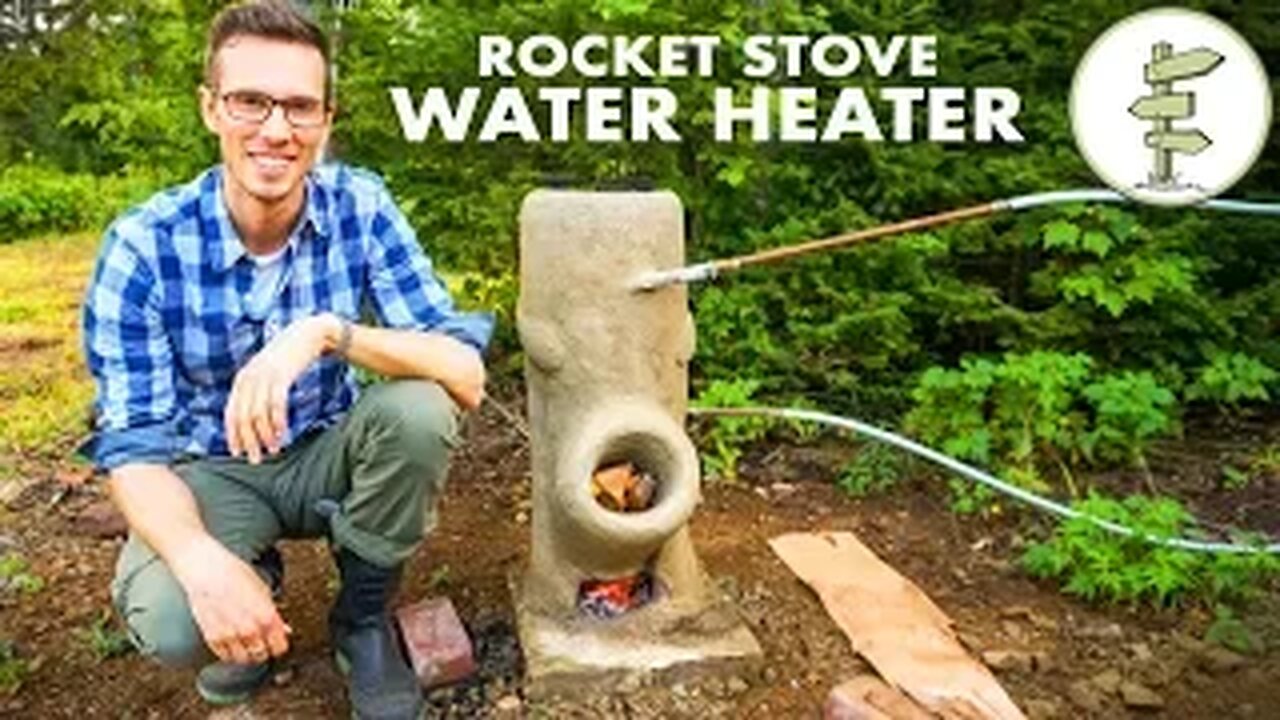Premium Only Content

Brilliant DIY Off-Grid Water Heater Using a Rocket Stove – No Propane!
To create an off-grid water heater using a clay rocket stove, you build a heat exchanger by coiling copper tubing within the stove's insulated clay chimney. As a fire burns in the stove, it heats the copper tubing, which in turn heats the water inside.
The system operates on the principle of thermosiphon, which naturally circulates water without a pump.
Materials and components
Clay/cob mixture: For building the stove body. Cob is a mixture of clay, sand, and straw.
Copper tubing: A 1/2-inch soft copper tubing is ideal for its heat conductivity and flexibility for coiling.
Water storage barrel: An elevated barrel or tank to hold the cold water supply.
Insulation material: Use cob, hay, or glass bottles to insulate the stove base and retain heat.
Stove forms: Use items like PVC pipe, buckets, and cardboard to shape the internal combustion and chimney chambers.
Connecting hoses: For linking the copper coil to the water barrel.
Safety equipment: A thermometer for checking water temperature and a steam relief valve for safety.
How to build the system
Prepare the clay: Mix your clay, sand, and straw to form a durable cob mixture.
The right consistency is crucial for creating the structure.
Build the stove base: Create a stable, insulated foundation for your stove. Lay down a base layer of cob and place materials like glass bottles or corrugated iron underneath to prevent ground moisture from wicking up.
Construct the rocket stove: Form the classic "J" shape of the rocket stove from your cob mixture, using forms to shape the combustion chamber, fuel feed, and insulated vertical chimney (heat riser).
Install the heat exchanger:
While building the vertical chimney, wrap the soft copper tubing in a tight coil around the chimney section. Leave the inlet and outlet ends extending outside the clay structure. Use sand to fill the tubing during bending to prevent kinking.
Add thermal mass: Cover the coiled copper tubing with more clay and insulation.
This thermal mass will absorb and radiate heat, keeping the water warm for a while even after the fire is out.
Connect the system:
Place your water storage barrel higher than the stove to facilitate thermosiphon.
Connect the copper coil's lower end to the bottom of the water barrel.
Connect the copper coil's upper end to the top of the barrel.
Test the system:
Start a small fire in the rocket stove's fuel chamber.
As the water in the copper coil heats, it will rise back into the barrel, drawing colder water into the coil from the bottom in a continuous cycle.
Monitor the water temperature with a thermometer to ensure it reaches a safe level.
How the thermosiphon principle works
Thermosiphon is a passive heat exchange method based on natural convection, which means it requires no mechanical pump.
Water is heated: The water inside the copper coils is heated by the high-temperature fire in the rocket stove's chimney.
Water rises: Hot water is less dense and rises out of the top of the coil, back into the elevated storage barrel.
Cold water sinks: Simultaneously, denser cold water from the bottom of the barrel is drawn into the bottom of the copper coil.
Continuous cycle: This natural cycle continues as long as the fire is burning, heating the entire volume of water in the barrel.
Pros and cons of a clay rocket stove water heater
Aspect Pros Cons
Energy source Uses wood, a renewable and easily accessible resource. Requires constant tending and feeding of wood to maintain heat.
Fuel efficiency Burns wood very efficiently and cleanly, producing minimal smoke. Can be less efficient than a traditional wood stove for heating large water volumes.
Circulation Operates without electricity using the thermosiphon effect. Requires careful design and placement of the water barrel relative to the stove.
Material cost Uses inexpensive materials like clay, sand, and straw. Copper tubing can be a significant cost.
Heating speed Heats water relatively quickly for its size.
May still take a couple of hours to heat a large barrel of water.
Versatility Can function as both a cooktop and water heater.
Not a practical solution for heating large buildings or large, continuous volumes of water.
Complexity Simple to build for DIYers with basic knowledge.
Requires skill to properly design and build the rocket stove and heat exchanger for maximum efficiency.
Modeling of a Heating System equipped with a
Biomeiler and a Heat Pump
Exploring Alternatives
-
 3:05:11
3:05:11
Inverted World Live
4 hours agoThe Halloween Special with Drea De Matteo and Sam Tripoli | Ep. 133
214K9 -
 2:57:52
2:57:52
Laura Loomer
7 hours agoEP154: Naturalized US Navy Medic From GAZA Exposed For Ties To Hamas
32.2K18 -
 35:45
35:45
Stephen Gardner
10 hours ago🔴BREAKING: Election Auditor EXPOSES Democrat Election Fraud Evidence!
21.5K37 -
 15:48
15:48
Sponsored By Jesus Podcast
14 hours agoHow to Stop Being JEALOUS | When Comparison Steals Your Joy
2.44K8 -
 LIVE
LIVE
DLDAfterDark
5 hours agoDon't Worry - Things Will Get SO Much Worse! Sometimes It Be Like That
515 watching -
 25:41
25:41
Robbi On The Record
10 hours agoThe Billion-Dollar Lie Behind OnlyFans “Empowerment” (Her Testimony Will Shock You) | part II
7.66K7 -
 12:22
12:22
Cash Jordan
2 hours ago"CHICAGO MOB" Fights Back... "ZERO MERCY" Marines DEFY Judge, SMASH ILLEGALS
15.8K28 -
 46:58
46:58
Brad Owen Poker
14 hours agoI Make QUAD ACES!!! BIGGEST Bounty Of My Life! Turning $0 Into $10,000+! Must See! Poker Vlog Ep 323
9K3 -
 2:52:28
2:52:28
TimcastIRL
5 hours agoSTATE OF EMERGENCY Declared Over Food Stamp CRISIS, Judge Says Trump MUST FUND SNAP | Timcast IRL
221K119 -
 3:22:45
3:22:45
Tundra Tactical
12 hours ago $14.22 earned🚨Gun News and Game Night🚨 ATF Form 1 Changes, BRN-180 Gen 3 Issues??, and Battlefield 6 Tonight!
34K2